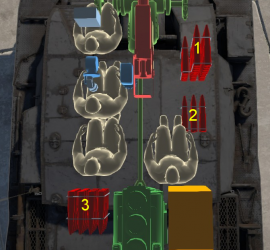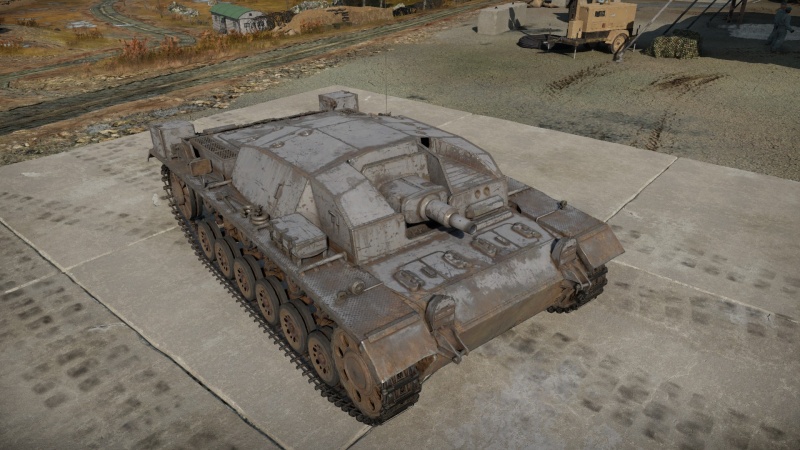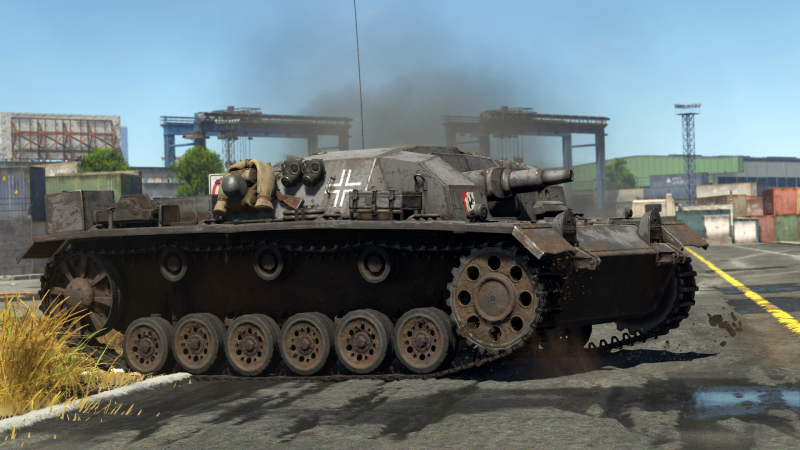StuG III A
| This page is about the German tank destroyer StuG III A. For other versions, see StuG III (Family). |
Contents
Description
The Sturmgeschütz III Ausführung A (StuG III A) (Sd.Kfz. Index: Sd.Kfz. 142) is the first variant of the Sturmgeschütz III assault gun family. It was the most-produced fully tracked armoured fighting vehicle, as well as the second-most-produced German armoured combat vehicle of any type, following the Sd.Kfz. 251 half-track. It was designed on a Panzer III F chassis that had been slightly modified, with the turret removed to be replaced by an armoured, fixed superstructure holding a more powerful gun. Originally designed as a mobile assault gun for direct-fire infantry support, the overall StuG III designs were continually upgraded and, like the subsequent Jagdpanzer vehicles, were used as a tank destroyer later during World War II. While the StuG III did not see action during the battle in Poland in September 1939, the experience acquired there highlighted the importance of a self-propelled mobile artillery vehicle.
Introduced in the Closed Beta Test for Ground Forces before Update 1.41, the StuG III A serves as an infantry support vehicle, similar to the early Panzer IV variants (A to F1). Its main objective was to fire high explosive (HE) shells in an arc at enemy fortifications and defence positions with its short-barrelled 75 mm Sturmkanone (StuK) 37 L/24 tank gun. In the game, the player can hide behind low obstacles and fight enemies while in the hull-down position. This greatly improves the StuG III A's survivability to resist opposing fire. Players new to the casemate tank destroyers in the German Army ground forces may struggle to adapt to the playstyle of such vehicles, particularly the frequent requirement to shift the direction of the hull when engaging the enemy from different directions. Nonetheless, gaining skill in playing such vehicles would undoubtedly benefit the players, as most German Army casemate tank destroyers are well-armoured compared to other vehicles of their rank, while also being armed with extremely powerful guns.
General info
Survivability and armour
Armour type:
- Rolled homogeneous armour
- Cast homogeneous armour (Gun mantlet)
| Armour | Front (Slope angle) | Sides | Rear | Roof |
|---|---|---|---|---|
| Hull | 26 mm (86°) Front glacis 50 mm (23°) Lower glacis |
30 mm | 30 mm | 17 mm |
| Superstructure | 50 mm (11°) Front plate | 30 mm | 30 mm | 11 mm |
Notes:
- Suspension wheels are 15 mm thick.
- Tracks are 20 mm thick.
Mobility
| Game Mode | Max Speed (km/h) | Weight (tons) | Engine power (horsepower) | Power-to-weight ratio (hp/ton) | |||
|---|---|---|---|---|---|---|---|
| Forward | Reverse | Stock | Upgraded | Stock | Upgraded | ||
| Arcade | Expression error: Unexpected * operator. | 426 | Expression error: Unexpected round operator. | __.__ | |||
| Realistic | 265 | Expression error: Unexpected round operator. | __.__ | ||||
Modifications and economy
Recommended research path:
- Parts and FPE (Fire Prevention Equipment, symbolised by the fire extinguisher)
- Usual Adjustment of Fire
- Both HEAT shells, to be able to deal with more heavily armoured threats, and then Elevation Mechanism
- Upgrades that improve mobility: Engine, Transmission, Filters
- Remaining upgrades
Armaments
Main armament
| 75 mm StuK37 | Turret rotation speed (°/s) | Reloading rate (seconds) | |||||||||||
|---|---|---|---|---|---|---|---|---|---|---|---|---|---|
| Mode | Capacity | Vertical | Horizontal | Stabilizer | Stock | Upgraded | Full | Expert | Aced | Stock | Full | Expert | Aced |
| Arcade | 44 | -10°/+20° | -9°/+5° | N/A | 7.0 | 9.8 | 11.8 | 13.1 | 13.9 | 4.29 | 3.80 | 3.50 | 3.30 |
| Realistic | 4.8 | 5.6 | 6.8 | 7.5 | 8.0 | ||||||||
Ammunition
| Penetration statistics | |||||||
|---|---|---|---|---|---|---|---|
| Ammunition | Type of warhead |
Penetration @ 0° Angle of Attack (mm) | |||||
| 10 m | 100 m | 500 m | 1,000 m | 1,500 m | 2,000 m | ||
| K.Gr.rot Pz. | APCBC | 52 | 51 | 45 | 39 | 34 | 30 |
| Hl.Gr 38B | HEAT | 80 | 80 | 80 | 80 | 80 | 80 |
| Hl.Gr 38C | HEAT | 115 | 115 | 115 | 115 | 115 | 115 |
| Sprgr. 34 | HE | 10 | 10 | 10 | 10 | 10 | 10 |
| Shell details | ||||||||||||
|---|---|---|---|---|---|---|---|---|---|---|---|---|
| Ammunition | Type of warhead |
Velocity (m/s) |
Projectile mass (kg) |
Fuse delay (m) |
Fuse sensitivity (mm) |
Explosive mass (TNT equivalent) (g) |
Ricochet | |||||
| 0% | 50% | 100% | ||||||||||
| K.Gr.rot Pz. | APCBC | 385 | 6.8 | 1.2 | 14 | 102.4 | 48° | 63° | 71° | |||
| Hl.Gr 38B | HEAT | 450 | 4.57 | 0.05 | 0.1 | 872.1 | 62° | 69° | 73° | |||
| Hl.Gr 38C | HEAT | 450 | 4.8 | 0.05 | 0.1 | 875.5 | 62° | 69° | 73° | |||
| Sprgr. 34 | HE | 420 | 5.74 | 0.2 | 0.1 | 686 | 79° | 80° | 81° | |||
| Smoke shell characteristics | ||||||
|---|---|---|---|---|---|---|
| Ammunition | Velocity (m/s) |
Projectile mass (kg) |
Screen radius (m) |
Screen deploy time (s) |
Screen hold time (s) |
Explosive mass (TNT equivalent) (g) |
| K.Gr.Rot Nb. | 423 | 6.2 | 9 | 5 | 20 | 50 |
Ammo racks

| Full ammo |
1st rack empty |
2nd rack empty |
3rd rack empty |
Visual discrepancy |
|---|---|---|---|---|
| 44 | 21 (+23) | 16 (+28) | 0 (+44) | No |
Notes:
- Racks disappear after you've fired all shells in the rack.
- Bigger rack in the front right empty: 21 (+23) shells.
- Right side completely empty: 16 (+28) shells.
Usage in battles
The StuG's AP shell can deal with many opponents at its rank. It has devastating when used on the many light tanks at Rank I, whilst your frontal armour can hold a lot of their shells. The front of a StuG III A is not invulnerable however, so you must be cautious as to which enemies you expose yourself to.
Do not use HE, it lacks the penetration of the HEAT and AP, and the explosive force of higher rank howitzers, such as the Sturmhaubitze and KV-2 have. The HEAT round is an excellent tool for sniping whilst even more important, cracking British heavy tanks, with both the Valentines and the Matilda not having enough armour to hold a HEAT projectile. Aim for their turrets, and you can easily destroy them in one shot, both being too slow and cumbersome to make use of your low-velocity cannon. HEAT rounds should be your main choice of ammo once you have researched it.
Due to the StuG III being made from the Panzer III chassis, this tank destroyer inherited its brilliant speed and mobility. This either makes it perfect at "shoot-and-scoot" tactics (i.e. destroying a tank then changing position) or flanking/head-on attacks, where your mobility can make you a hard target to hit. While the StuG series lacks a turret, it can turn on the spot very fast and has a decent gun arc, providing you have cover or able teammates which can negate the lack of a turret with the track traverse.
One of the huge disadvantages of the StuG III A is the lack of a turret that can traverse and unsloped side armour. The limited field of fire severely hampers the StuG's urban capabilities. The flank of the StuG is also unsloped and thin, making it extremely easy to penetrate if exposed. However, the StuG has a very low profile and good frontal sloping, affording it excellent protection when shooting from a gap in rocks or obstacles.
If you have a side shot on this vehicle, attempt to disable its tracks; this will make accurate aiming more difficult for the StuG driver as well as make the turning time of the tank destroyer increase, giving you more time to shoot the StuG without receiving shots in return. The StuG III A is weak in the sides, giving you prime shots at the particularly frail engine and ammo rack. The armour is unsloped on the sides and therefore offers little protection.
Overall, the StuG III A is an early devastating tank to face, with its pros outweigh its cons. The lack of turret is overlooked when the combination of HEAT rounds, fast mobility, quick reload, and decent armour comes into play.
Pros and cons
Pros:
- Possesses a powerful gun against its opponents
- Low profile due to casemate structure
- HEAT options are very effective in dealing with heavily-armoured vehicles
- Good handling and mobility, quick turning response
- Fast loading speed
- Good frontal armour of 50 mm
- Difficult to penetrate from upper frontal armour due to the various sloping areas, where most inexperienced players will fire
Cons:
- Flat weak spots in the front superstructure, that crew and ammunition are right behind
- Sides are extremely vulnerable as they are unsloped and thin
- Due to your lack of a turret, you are defenceless once immobile and are easy to pick off if the enemy can target your side
- 3-man crew can be knocked out with a well-placed shot through the driver's port
- Stock APCBC ammo has low penetration, ~50 mm at close range
- Limited fire arc due to the gun mount
- High shell arc due to slow muzzle velocity
History
Development
The role of a self-propelled gun came from combat experiences in World War I. During the German offensives on the Allied front, infantry lacked artillery support against fortifications in places out-ranged by their heavy artillery behind the lines. A need for a mobile artillery piece was necessary to keep up with the German infantry and fight enemy fortifications with a direct-fire assault role. The father of this concept was German General Erich von Manstein and was coined as the Sturmartillerie (assault artillery), and these units were to be embedded in infantry divisions.
On June 15, 1936, Daimler-Benz AG was ordered to develop a support vehicle mounting the 75 mm howitzer as its armament in a casemate structure with a traverse of 25 degrees. The vehicle was to provide full protection for its crew and be no taller than an average soldier. Daimler-Benz repurposed the chassis and running gear of their Panzer III design for the role. These new vehicles were named the Sturmgeschütz III (assault gun), or the shortened StuG III and the finished designs were sent to Alkett for prototype production and five were produced in 1937. These prototypes were made of mild steel and had the 75 mm StuK 37 L/24 cannon, an adaption of the original 75 mm KwK 37 cannon on the Panzer IV. This gun would be featured on the StuG III variants Ausf. A to Ausf. E. The StuG III entered production from January 1940 to the end of the war on April 1945 due to the many upgrades done on the vehicle to increase serviceability and its low cost. At about a total production of 11,300 StuG III and its variants, the StuG III design was the most produced armoured fighting vehicle in German service. However, only about 36 vehicles of the Ausf. A variant was produced from January to May in 1940 before it was upgraded.
Design
The StuG III had a fully enclosed armoured structure, keeping the crew safe within the vehicle. As a casemate structure, it has a limited traverse range for its front view, and the whole vehicle must be turned if a target is outside its traverse range. The StuG III featured about 50 mm of armour on the front, but about 30 mm of armour everywhere else. The suspension system is identical to the Panzer III's, a torsion bar system. The StuG III had a crew of four, the commander, driver, loader, and gunner. Initial variants lack machine guns, so the StuG was required to work with support units to ensure it does not get overrun by infantry. It wasn't until December 1942 when a machine gun could be accommodated for the loader to use. Initial variants also did not have a commander's cupola so his view was quite restricted. However, models after September 1943 had them installed.
Combat usage
The StuG III was placed in the artillery branch of the Wehrmacht Heer as neither the infantry nor Panzer forces could accept the StuG vehicle. The StuGs were organized into battalions with 18 vehicles organized into three batteries of six vehicles each. The intent of the vehicle was to provide close support for infantry and so it was meant to destroy lightly-armoured targets and fortifications, not tanks. The vehicle served well in its intended role in the early parts of World War II in Poland and France Campaigns, proving highly successful. One prominent commander of the StuG III is Michael Wittman, who would eventually become the most popular tank ace in German service. However, during the German campaigns in World War II, they encounter more heavily armoured and armed tanks in the Allied sides, such as the French heavy tank Char B1, but it was the Soviets T-34 and KV-1 tanks that made the Germans rearm their vehicles to be better able to combat these tanks. Thus, the StuG III Ausf. A was upgraded with a 75 mm StuK 40 L/43 gun on the Ausf. F and the 75 mm StuK 40 L/48 gun on the Ausf. G, effectively turning these assault guns into a dual-purpose role as a tank destroyer as well. Also, go for hills for sniping when there is a lot of enemies (Ash's river south base capture when play on the left side)
The StuG III design was also made into different variants with different armaments, such as a 105 mm howitzer on the StuH 42 , a flamethrower on the StuG III (Flamm), and even a 150 mm sIG 33 infantry gun on the Sturm-Infanteriegeschütz 33B.
The StuG III was a widely-exported design to Germany's allies, such as Bulgaria, Hungary, Italy, Romania, Spain, and Finland. The StuG III would continue serving in various countries past World War II in conflicts in the 1960s, such as the Six Days War in Syria's service that was donated by the Soviet Union. Today, some are still serving as static pillboxes on the Golan Heights.
| Archive of the in-game description | |
|---|---|
|
Designs and samples of a self-propelled anti-aircraft gun built from a Pz. III began to be produced by the company Daimler-Benz AG in 1938. But only after the Polish campaign, which exposed the acute shortage of mobile field artillery in parts of the Wehrmacht, was the first production batch of machines launched, designated Sturmgeschütz III Ausf. A (abbreviated StuG III Ausf. A) in February 1940. The basis for the new machines was the Pz.Kpfw. III Ausf. F tank, which had a conning tower installed instead of the hull's superstructure and turret. The assault vehicle was armed with a short-barreled 75 mm StuK37 L/24 gun with 44 shells. The armour for the hull and the turret was increased by adding additional 20 mm armour plates. This resulted in a maximum armour thickness of 50 mm. From January to May 1940, 30 StuG III Ausf. A vehicles were produced. The new assault guns joined the 640th, 659th, 660th, and 665th artillery assault divisions and participated in combat in France, where they had a very successful combat debut. The Sturmgeschütz III Ausf. A also took part in the attack on the USSR. The most popular tank ace of World War II, Michael Wittmann, began his combat career in this vehicle. The assault guns were supplied to Germany's allies: Romania, Bulgaria, Finland, Italy, Hungary, and Spain. In the 1950, the assault guns served in Romania, Spain, Egypt, and Syria. The StuG III became the most widespread specimen of German armoured vehicles from World Wad II and proved itself well in battle. The vehicle's major drawback was its lack of a machine gun and the low muzzle velocity of its projectiles. As a result, the self-propelled gun was defenseless in close combat and against well-armoured tanks. Therefore, the StuG III was only rarely deployed without supporting forces. | |
Media
- Skins
See also
Links to the articles on the War Thunder Wiki that you think will be useful for the reader, for example:
- reference to the series of the vehicles;
- links to approximate analogues of other nations and research trees.
External links
| Germany tank destroyers | |
|---|---|
| Pz. I Derivatives | Panzerjäger I |
| Pz. II Derivatives | 15cm sIG 33 B Sfl |
| Pz. 38(t) Derivatives | Marder III · Marder III H · Jagdpanzer 38(t) |
| Pz. III Derivatives | StuG III A · StuG III F · StuG III G · StuH 42 G |
| Pz. IV Derivatives | Jagdpanzer IV · Panzer IV/70(A) · Panzer IV/70(V) · Dicker Max · Nashorn · Brummbär · VFW |
| Pz. V Derivatives | Jagdpanther G1 · Bfw. Jagdpanther G1 |
| Pz. VI Derivatives | Sturer Emil · Elefant · Ferdinand · 38 cm Sturmmörser · Jagdtiger |
| Wheeled/Half-track | 8,8 cm Flak 37 Sfl. · Sd.Kfz.251/9 · Sd.Kfz.251/10 · Sd.Kfz.251/22 · Sd.Kfz.234/3 · Sd.Kfz.234/4 · 15 cm Pz.W.42 |
| ATGM Carrier | RakJPz 2 · RakJPz 2 (HOT) · Wiesel 1A2 |
| Other | Waffenträger · M109G · JPz 4-5 · Raketenautomat · VT1-2 |






